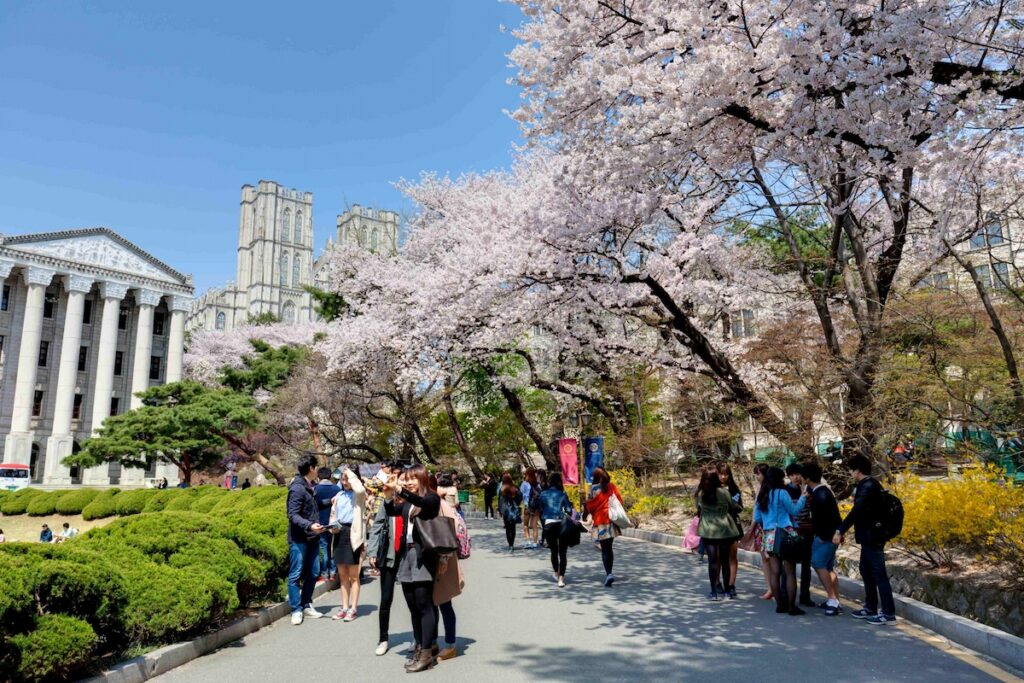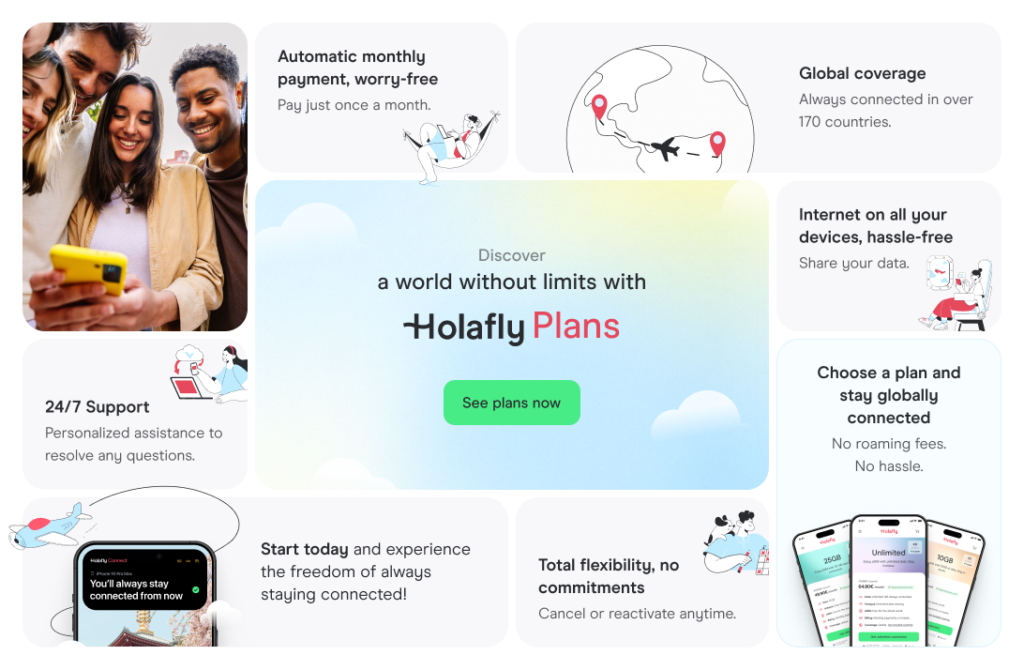Thinking of doing an exchange program? Here’s everything you need to know
Explore study abroad opportunities, and learn how to get accepted and prepare for your journey.
Picture yourself sipping a café au lait in a cozy Parisian café, surrounded by new friends from around the world. Dreamy, right? That’s the kind of unforgettable experience an exchange program offers. It opens the door to new cultures, lasting connections, and lifelong memories.
Wondering how to find, apply, and prepare for your study abroad adventure? This guide breaks it all down into simple, easy-to-follow steps. Stick until the end for a stress-free way to stay connected as soon as you land.
What is an exchange program?
An exchange program is more than just a trip abroad. It’s an immersive experience that allows students to fully engage with a new culture and experience daily life in a different part of the world firsthand.
In addition to studying at a host school or university, you’ll have the chance to meet students from all over the world, engage in local activities, and practice a new language.
Exchange programs range from a few weeks to an entire academic year, with most programs aimed at students 16 or older. Keep in mind, age and academic requirements vary by program.
You can find exchange programs in one of two ways: through your school or by researching specialized exchange organizations. In either case, your school or program provider will typically handle logistics like housing, activities, and sometimes meals.

Who can go?
Some exchange programs are built into your degree, like spending a semester in Japan if you’re studying Japanese. But you don’t need to be a language major to study abroad. Opportunities are available across a range of fields, from science and business to arts and engineering. Still in high school? Plenty of programs offer cultural and language immersion, too.
Accommodation options & meals
Typically, your program provider or school arranges accommodation, though in some cases, students can choose and plan their own housing (check your program for specifics).
Curious about where you’ll stay? Here are some common options:
- Host Family: You’ll share daily life, routines, and usually meals with your hosts. It’s great for language practice and provides a built-in support system, especially useful if it’s your first time living away from home.
- Student Dormitories: You’ll be living with other students, typically both local and international. Dorms often feature shared facilities like common rooms or kitchens. Meals might be self-catered, available in a canteen, or covered by a stipend.
- Coliving: While less common in traditional programs, it can sometimes be an option. This might include shared apartments or dedicated coliving spaces with a community focus. Typically, students need to arrange this type of accommodation themselves.
What activities are involved?
Most programs offer a structured schedule that balances learning with leisure. You can expect organized activities like language classes, cultural workshops, museum visits, and social events.
Wondering if you’ll have time to explore on your own? While most exchange programs include free time, the amount will depend on the program’s structure and rules.
Popular exchange program destinations

Eager to find out where your exchange could take you? While opportunities exist worldwide, popular destinations include:
- European Hubs: Countries like Spain, France, or Germany attract many students for their rich history, language opportunities, and well-established university networks (including Erasmus+).
- East Asia: Japan and South Korea are increasingly popular for their unique blend of traditional culture and modern innovation.
- North America: The USA and Canada offer many study abroad opportunities and diverse cultural experiences.
It’s easy to be drawn to a program because it’s in your dream city. But remember, you’ll spend a lot of time studying (sorry to be the ones to break the news!). Take the time to research the program’s curriculum and academic requirements before making your decision.
That being said, keep an open mind! You may find yourself in places you never expected—it’s part of the adventure.
Types of exchange programs
While academic study is the most common, exchange programs come in many forms. Other types include:
- Cultural Exchanges: Focused on language learning and cross-cultural understanding
- Education Exchanges: Involve taking academic courses at a host institution
- Voluntary Programs: Combine cultural immersion with contributing to community projects
- Sports Exchanges: Allow students to train and compete internationally
- Erasmus+: A well-known program facilitating exchanges, primarily within Europe
For this guide’s detailed look at applying and preparing, we’ll concentrate on the steps most relevant for education exchange programs.
The application journey: Steps to study abroad
Want to learn how to find and get accepted to a program? The application process involves several steps, and getting started early is key.
Finding your exchange program
Start by visiting your school’s study abroad office or talking to your high school counselor. They can help you find programs and guide you on what to do next.
From there, you can explore online databases like Go Overseas and GoAbroad.com, where you can filter international exchange programs by location, subject, or length to find something that fits.
It’s worth looking into well-known international education organizations like IES Abroad, CIEE, and AIFS Abroad. They offer a wide range of trusted programs across the globe.
Don’t skip government education and cultural exchange sites like EducationUSA (for the US), or DAAD (for Germany), which list official programs, grants, and scholarships.
And if you have a chance, attend in-person info sessions or study abroad fairs. They’re a great way to get a feel for what’s out there and ask questions.

Documents
Some documents you might have to submit:
- A detailed application form
- Official academic transcripts (showing your grades)
- Letters of recommendation (choose professors who know you well!)
- An exchange program application essay (almost always required)
Depending on the specific program or your field, you might need to submit proof of language skills (like a test score) or a portfolio (especially in arts or design). Always double-check the specific document requirements for each program you’re interested in.
Exchange program application essay
Your application essay is your chance to show who you are beyond your grades. It’s where you explain why you want to join the program, what excites you about cultural immersion, and why you’re ready for the experience. Be genuine, answer the prompt clearly, and don’t forget to proofread—strong writing makes a strong impression.
Timeline
Application deadlines can be six months to a full year before a program’s departure date. Start early and factor in time for research, requesting recommendations, writing your essay, and gathering transcripts.
Costs
Program costs can vary significantly. Always ask for a full breakdown from potential program providers. Importantly, look beyond the main program fee when budgeting for your exchange. Here are some other costs to factor in:
- Application fees
- International flights
- Visa application costs
- Travel and health insurance
- Daily local transportation & meal costs
- Personal spending money
- Any other travel you might want to do
Although international exchange programs can be pricey, don’t assume you can’t afford it! Check with your school’s financial aid office and research external funding databases. Many scholarships, grants, and bursaries exist specifically for exchanges.
Getting ready for your adventure
There’s more to prepping for an exchange than just packing your suitcase. Make sure to:
- Check visa requirements early—these depend on your destination, nationality, and length of stay, and applications can take time.
- Research your host country’s culture and customs, including any important laws or local etiquette.
- Sort out your finances, like international banking options or notifying your home bank.
- Confirm your health insurance coverage for the duration of your stay abroad.
- Attend pre-departure orientations offered by your program—they’re full of practical tips and a chance to meet other exchange students.
- Take any prep courses on culture or logistics if your program offers them—they’ll make your transition smoother.
And finally, don’t forget to plan how you’ll stay connected during your trip (hint: we’ve got you covered in the next section).
Bridging the language gap

Even if English is widely spoken in your host country or classes, learning the local language will seriously level up your exchange experience. It will help you connect with local people and handle daily life more confidently.
Check whether your program includes language courses before departure or on arrival. If you’re headed somewhere like Spain, France, Japan, or Germany, you’ll have no shortage of options—from university-led classes to private language schools.
And of course, apps like Duolingo or Babbel are great for picking up the basics, and easy to squeeze in whenever you’ve got a few spare minutes.
Staying connected seamlessly abroad
Imagine landing in your new city and having to rely on spotty public Wi-Fi to find your host’s house. Or burning through your budget with roaming charges before the week’s even out. Not ideal.
A reliable internet connection saves you from all those headaches. While a standard eSIM might do for a quick trip, exchange programs usually mean months abroad. That’s where Holafly’s long-term eSIM plans come in. They’re flexible and designed for extended stays.
Global internet subscription plan – Holafly Plans
Holafly Plans is Holafly’s international eSIM subscription plan. Instead of purchasing an eSIM for a limited time, you can now subscribe to a monthly plan that renews automatically. One fixed payment per month, global coverage in over 170 countries, and instant activation. No matter where you go or how long you stay—you’re covered.
Sounds amazing? It gets better. Holafly Plans offers not one but three plans, all with 5G speeds and global coverage. You can switch plans as needed or cancel anytime. Even if you cancel, your connection stays active until the end of the billing cycle.
Choose the plan that fits your needs:
- 10 GB Plan – Perfect for travelers with moderate data needs. Stay active on social media, check emails, or search for local spots and transport schedules. All your essentials are covered. Monthly price: €39.90 / $40.93.
- 25 GB Plan – Great for those who often make video calls, use collaboration platforms, download files, or stream content occasionally. Monthly price: €49.90 / $51.19.
- Unlimited Plan – The ultimate choice. Designed for digital natives who rely on the internet all day, every day. Ideal for remote workers who join video meetings, use cloud-based tools, and juggle dozens of browser tabs while streaming music to focus. If that’s you—this is your plan. Monthly price: €64.90 / $67.90.
Important: If you are a frequent traveler and want to stay connected without worrying about expensive roaming or looking for a new SIM at every destination, Holafly’s subscription plans are for you. With a single eSIM, enjoy internet in more than 170 countries for a fixed price and no surprises on your bill. Travel without limits and connect easily and securely! 🚀🌍

Ready to turn your exchange program dream into reality? Studying abroad is both exciting and challenging. From facing language barriers to navigating unfamiliar surroundings, you’ll step outside your comfort zone. Holafly’s eSIM plans help keep things seamless so you can explore your new city, stay in touch with your host family and program staff, check course updates, and keep connected with loved ones back home.





 Language
Language 


















 No results found
No results found








